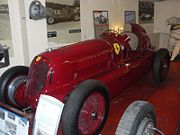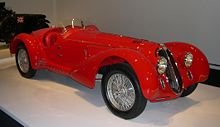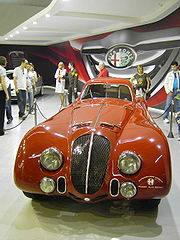
Alfa Romeo 8C
Encyclopedia
1935 Monoposto 8C 35 Type C

Scuderia Ferrari
Scuderia Ferrari is the racing team division of the Ferrari automobile marque. The team currently only races in Formula One but has competed in numerous classes of motorsport since its formation in 1929, including sportscar racing....
. (The P3 designation was dropped.) The 3.8 produced 330 bhp at 5500 rpm, and had 320 lbft from 900 rpm to 5500 rpm. It had 15.5-inch drum brakes all round, using Pirelli
Pirelli
Pirelli & C. SpA is a diverse multinational company based in Milan, Italy. The company, the world’s fifth largest tyre manufacturer, is present in over 160 countries, has 20 manufacturing sites around the world and a network of around 10,000 distributors and retailers.Founded in Milan in 1872,...
5.25 or 5.50 x 19 tyres at the front and 7.00 or 7.50 x 19 tyres at the rear. Though not a match for the big Mercedes and Auto Union on the faster circuits, they came into their own on the tighter circuits and races. In 1936 Tipo Cs fitted with the troublesome V12 did not live up to expectations, and the 3.8 continued to be used. From 1933 Scuderia Ferrari had managed the racing, and the Ferrari prancing horse appeared on the flanks of the Bimotore, but Alfa Corse began to become more active, and Vittorio Jano went at the end of the 1937 season. In 1938 four Alfa Romeo Tipo 308
Alfa Romeo Tipo 308
The Alfa Romeo 308 or 8C-308 is a Grand Prix racing car made for the 3 litre class in 1938, only four cars was produced, actually modified from Tipo C with the engine mounted lower into the chassis and a slimmer body. The chassis was derived from the Tipo C and the engine from the 8C 2900...
racers were built for the three litre class using 8C engines.
1935 Bimotore

Mercedes-Benz in motorsport
Throughout its long history, Mercedes-Benz has been involved in a range of motorsport activities, including sportscar racing and rallying, and is currently active in Formula Three, DTM and Formula One.-Early history:...
and Auto Union
Auto Union
Auto Union was an amalgamation of four German automobile manufacturers, founded in 1932 and established in 1936 in Chemnitz, Saxony, during the Great Depression. The company has evolved into present day Audi, as a subsidiary of Volkswagen Group....
, Enzo Ferrari
Enzo Ferrari
Enzo Anselmo Ferrari Cavaliere di Gran Croce OMRI was an Italian race car driver and entrepreneur, the founder of the Scuderia Ferrari Grand Prix motor racing team, and subsequently of the Ferrari car manufacturer...
(Race team manager) and Luigi Bazzi (Designer) built a racer with two 3.2 (3.165 litre) engines, one in the front and one in the rear, giving 6.3 litres and 540 bhp. The drivetrain layout was unusual. The two engines were connected by separate driveshaft to a gearbox with two input shafts, and two angled output shafts, so each of the rear wheels had its own driveshaft. It could never quite succeed against the Mercedes W25 B of Rudolf Caracciola
Rudolf Caracciola
Otto Wilhelm Rudolf Caracciola , more commonly Rudolf Caracciola , was a racing driver from Remagen, Germany. He won the European Drivers' Championship, the pre-1950 equivalent of the modern Formula One World Championship, an unsurpassed three times...
, and was hard on fuel and tyres. The gain in speed was offset by increased pit times. On May 12, 1935, two were entered in the Tripoli Grand Prix
Tripoli Grand Prix
The Tripoli Grand Prix was a motor racing event first held in 1925 on a racing circuit outside Tripoli, the capital of what was then Italian Tripolitania...
driven by Nuvolari and Chiron who finished fourth and fifth. Chiron managed a second at the following 1935 Avus race. On June 16, 1935 Nuvolari drove a specially prepared Bimotore from Florence to Livorno and set a new speed record 364 km/h (226.2 mph) with an average speed of over 323 km/h (200.7 mph). After that it was sidelined in favour of the Tipo C. It was the first racer to use the Dubonnet independent trailing arm front suspension. The V12 was under development, but was not race ready. It was noticed that the Bimotore had a traction advantage on rough ground, so a version of the Bimotore chassis with the independent Dubonnet front end, and a new independent rear with swing axles with radius rods and a transverse leaf spring was used for the Tipo C 3.8s.
1936 8C 2900A
In 1936 the '8C 2900A' model was introduced, as a twin seater version of the 8C-35 GP racer, with rear-mounted gearbox and full independent suspension. The 8C2900A was also a race car intended for the Sports Car category. Fewer than a dozen were built, followed by the '8C 2900B', very similar but also sold as road car in about 30 examples. At the same time Alfa Romeo's Tipo B 3.2 litre was becoming less competitive, yet Tazio NuvolariTazio Nuvolari
Tazio Giorgio Nuvolari was an Italian motorcycle and racecar driver, known as Il Mantovano Volante or Nivola. He was the 1932 European Champion in Grand Prix motor racing...
managed the exploit of winning the 1935 German GP at the Nürburgring
Nürburgring
The Nürburgring is a motorsport complex around the village of Nürburg, Germany. It features a modern Grand Prix race track built in 1984, and a much longer old North loop track which was built in the 1920s around the village and medieval castle of Nürburg in the Eifel mountains. It is located about...
at the wheel of a 3.2 Tipo B against the more powerful Mercedes and Auto Union. The blocks had reached their capacity limit, and a new casting was needed to further enlarge the engine capacity to its final size of 3.8 litres. This was done in 1935 to be fitted into the Monoposto Tipo C which entered its first race at the Italian Grand Prix
Italian Grand Prix
The Italian Grand Prix is one of the longest running events on the motor racing calendar. The first Italian Grand Prix motor racing championship took place on 4 September 1921 at Brescia...
in September 1935. Earlier that year, another attempt to challenge the German car's superior power had been made with the Bimotore (basically a Tipo B modified at the Scuderia Ferrari with a second engine behind the driver), which raced at the 1935 Tripoli GP and AVUS GP, with little success as the tyres couldn't cope with the car's power and weight. The Monoposto Tipo C (aka 8C 35) 3.8 was entered with some success during the 1936 season, followed by the 12C36, a Tipo C now fitted with a new V12 engine of 4064 cc. In the major races, the Monoposto 12C
Alfa Romeo 12C
The Alfa Romeo 12C or Tipo C was a 12 cylinder Grand Prix car. The 12C-36 made its debut in Tripoli Grand Prix 1936, and the 12C-37 in Coppa Acerbo 1937. The 12C36 was a Tipo C fitted with the new V12 instead of the 3.8 straight-eight of the 8C-35...
36 and 37 could not match the Mercedes and Auto-Union cars.
1938 8C 2900B Mille Miglia Roadster

Spider
Spiders are air-breathing arthropods that have eight legs, and chelicerae with fangs that inject venom. They are the largest order of arachnids and rank seventh in total species diversity among all other groups of organisms...
) pictured is the ultra-light short-chassis (Corto) competition version, with a Carrozzeria Touring
Carrozzeria Touring
Carrozzeria Touring is an automobile coachbuilder established on March 25, 1926 in Milan, Italy by Felice Bianchi Anderloni and Gaetano Ponzoni...
(patented) Superleggera
Superleggera
Superleggera is an automobile chassis construction technology developed by Felice Bianchi Anderloni of Italian coachbuilder Carrozzeria Touring. The company was located just north of Milan, near Alfa Romeo, Italian Citroen, and the former Isotta-Fraschini plant...
body. The motor was 2.9 litres. This was the fore-runner of modern Alfa Romeos, in that the 2900B had hydraulic 17 inches (432 mm) brakes, fully independent suspension and a four speed rear transaxle
Transaxle
In the automotive field, a transaxle is a major mechanical component that combines the functionality of the transmission, the differential, and associated components of the driven axle into one integrated assembly....
, instead of the live rear axle
Live axle
A live axle, sometimes called a solid axle, is a type of beam axle suspension system that uses the driveshafts that transmit power to the wheels to connect the wheels laterally so that they move together as a unit....
of earlier models. It had 19-inch rims and used 5.5 inches (140 mm) Pirelli Corsa tyres front and rear.
In the 1938 Mille Miglia
Mille Miglia
The Mille Miglia was an open-road endurance race which took place in Italy twenty-four times from 1927 to 1957 ....
, Clemente Biondetti
Clemente Biondetti
Clemente Biondetti was an Italian auto racing driver.-Biography:Born in Buddusò, Sardinia, into a working class family, Biondetti began racing motorcycles in 1923 but in 1927 turned to automobiles...
and Carlo Pintacuda
Carlo Maria Pintacuda
Carlo Maria Pintacuda was a motor-racing driver from Italy.born in Florence, he was one of the greatest drivers from the "Florentine School" alongside Emilio Materassi, Gastone Brilli-Peri, Clemente Biondetti and Giulio Masetti, and won two editions of legendary Mille Miglia races, in 1935 and 1937...
took the first two places. Biondetti's car used a 300 bhp Tipo 308 engine, while Pintacuda's used a 225 bhp 2900B. Phil Hill
Phil Hill
Philip Toll Hill, Jr., was a United States automobile racer and the only American-born driver to win the Formula One World Drivers' Championship. Hill was described as a "thoughtful, gentle man" and once said, "I'm in the wrong business. I don't want to beat anybody, I don't want to be the big hero...
won several west coast United States races in Pintacuda's car in 1951 before driving for Ferrari
Ferrari
Ferrari S.p.A. is an Italian sports car manufacturer based in Maranello, Italy. Founded by Enzo Ferrari in 1929, as Scuderia Ferrari, the company sponsored drivers and manufactured race cars before moving into production of street-legal vehicles as Ferrari S.p.A. in 1947...
.
The engine in a production 2900B is a dry sump
Dry sump
A dry sump is a lubricating motor oil management method for four-stroke and large two-stroke piston internal combustion engines that uses external pumps and a secondary external reservoir for oil, as compared to a conventional wet sump system....
twin Scintilla magneto
Magneto
A magneto is a type of electrical generator.Magneto may also refer to:* Magneto , permanent magnetic alternating current rotary generator* ignition magneto, magnetos on internal combustion engines...
supercharged inline 8-cylinder 2.9 litre using two Roots type supercharger
Roots type supercharger
The Roots type supercharger or Roots blower is a positive displacement lobe pump which operates by pumping fluids with a pair of meshing lobes not unlike a set of stretched gears. Fluid is trapped in pockets surrounding the lobes and carried from the intake side to the exhaust...
s fed by two updraught Weber carburettors
Weber carburetor
Weber is an Italian company producing carburetors, currently owned by Magneti Marelli Powertrain S.p.A., in turn part of the Fiat Group.The company was established as...
. The output was 180 bhp and was the world's fastest production road car in 1938. (Competition versions gave 220 bhp at 5200 rpm) About 30 short-wheelbase (2800 mm (110.2 in)) 2900B models were built, mostly with spider bodywork by Touring and Farina
Pininfarina
Pininfarina S.p.A. is an Italian car design firm and coachbuilder in Cambiano, Italy.Founded as Società anonima Carrozzeria Pinin Farina in 1930 by automobile designer and builder Battista "Pinin" Farina, Pininfarina has been employed by a wide variety of high-end automobile manufacturers,...
, about ten Lungo, long wheelbase
Wheelbase
In both road and rail vehicles, the wheelbase is the distance between the centers of the front and rear wheels.- Road :In automobiles, the wheelbase is the horizontal distance between the center of the front wheel and the center of the rear wheel...
, (3000 mm (118.1 in)) models were built. and only five with the Mille Miglia bodywork also by Touring of Milan
Milan
Milan is the second-largest city in Italy and the capital city of the region of Lombardy and of the province of Milan. The city proper has a population of about 1.3 million, while its urban area, roughly coinciding with its administrative province and the bordering Province of Monza and Brianza ,...
. All were coachbuilt to the owners specification, so few, if any, are exactly alike.
The last time a roadster was auctioned, in August 1999, by Christie's at Pebble Beach, it brought four million and seventy two thousand US dollars, making it one of the ten most expensive cars ever auctioned
Most expensive cars sold in auction
This is a list of the most expensive cars sold in auto auctions through the traditional bidding process, consisting of those that attracted headline grabbing publicity, mainly for the high price their new owners have paid...
. The Mille Miglia roadsters are even more valuable, so valuable that some owners of the more usual Farina or Touring Spiders have had them professionally rebodied to match the Touring Mille Miglia Spider, as driven by Biondetti.
Technical drawings of the 2900B Mille Miglia by the American historian Jonathan Thompson survive. (They are included in Simon Moore's book, The Immortal 2.9, and are viewable online - See External links)
1938 8C 2900B Le Mans Speciale

External links
- vsronline.com Page 3. A modellers plan website; featuring Jonathon Thompson's plans for the 1938 Alfa Romeo 8C 2900B Mille Miglia Roadster, front, rear, and RH side views, as used in Simon Moore's book, "The Immortal 2.9"
- vsronline.com Page 4. The LH side and above views of the above mentioned plans. The other pages not linked here are readable .jpg s of an article on the Mille Miglia Roadster.

